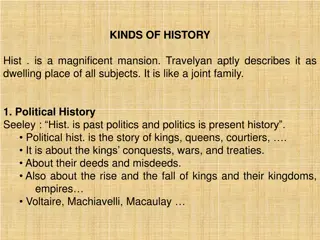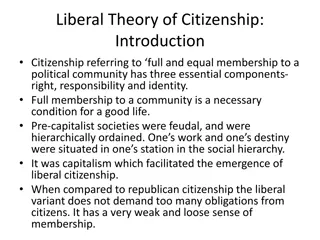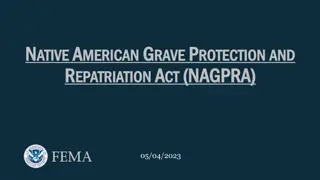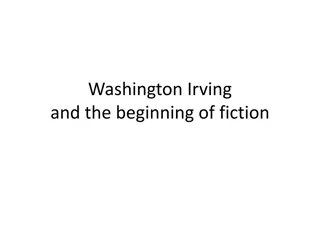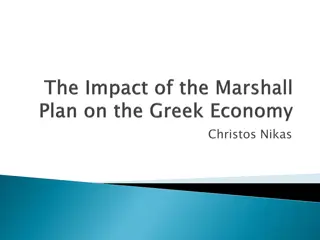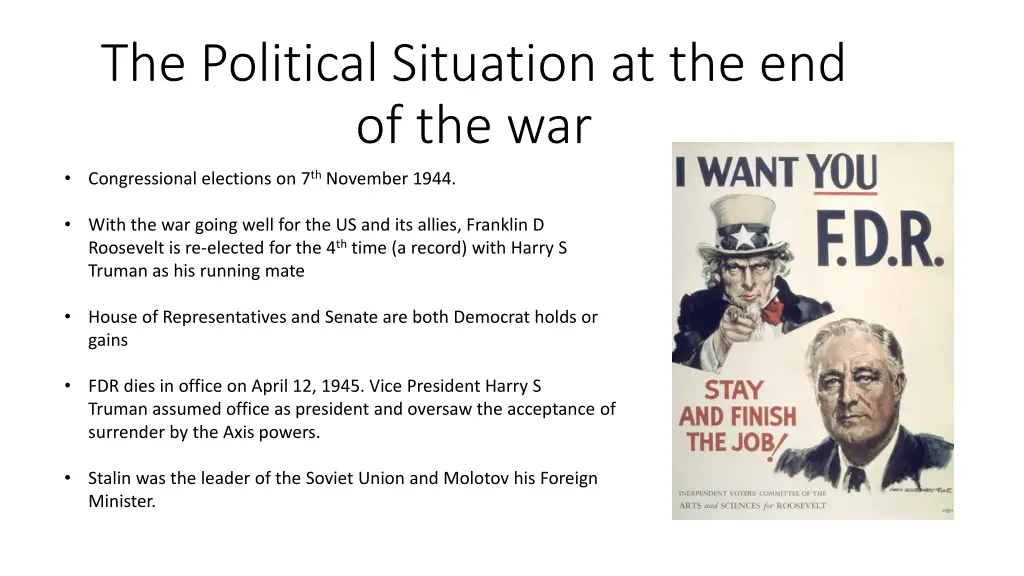
World War II Post-War Political Developments and Aid Programs
Learn about the post-World War II political situation, including the re-election of Franklin D. Roosevelt, Truman Doctrine, and Marshall Plan. Explore the key events that shaped the international landscape and economic recovery efforts in Europe. Understand the significant roles of leaders like Roosevelt, Truman, and Marshall in rebuilding and stabilizing nations post-war.
Uploaded on | 2 Views
Download Presentation

Please find below an Image/Link to download the presentation.
The content on the website is provided AS IS for your information and personal use only. It may not be sold, licensed, or shared on other websites without obtaining consent from the author. If you encounter any issues during the download, it is possible that the publisher has removed the file from their server.
You are allowed to download the files provided on this website for personal or commercial use, subject to the condition that they are used lawfully. All files are the property of their respective owners.
The content on the website is provided AS IS for your information and personal use only. It may not be sold, licensed, or shared on other websites without obtaining consent from the author.
E N D
Presentation Transcript
The Political Situation at the end of the war Congressional elections on 7th November 1944. With the war going well for the US and its allies, Franklin D Roosevelt is re-elected for the 4th time (a record) with Harry S Truman as his running mate House of Representatives and Senate are both Democrat holds or gains FDR dies in office on April 12, 1945. Vice President Harry S Truman assumed office as president and oversaw the acceptance of surrender by the Axis powers. Stalin was the leader of the Soviet Union and Molotov his Foreign Minister.
The Truman Doctrine The name arose from a speech by President Truman to both houses on March 12th 1947. In light of the deteriorating relationship with the Soviet Union during 1946 The appearance of Soviet meddling in Greek and Turkish affairs The withdrawal of British military and economic assistance to Greece President Truman requested that Congress provide $400,000,000 worth of aid to both the Greek and Turkish Governments and support the dispatch of American civilian and military personnel and equipment to the region. A break with traditional avoidance of foreign intervention during peacetime The Truman Doctrine committed the United States to actively offering assistance to preserve the political integrity of democratic nations when such an offer was deemed to be in the best interest of the United States.
The Marshall Plan Europe After World War II Post-war Europe was in dire straits: Millions of its citizens had been killed or seriously wounded. Many European cities had been almost completely destroyed. This included the UK. Transport infrastructure railways, roads, bridges, and ports had suffered extensive damage during airstrikes, and the shipping fleets of many countries had been sunk. Reports provided to Marshall suggested that some regions of the continent were on the brink of famine because agricultural and other food production had been disrupted by the fighting. In fact, it could easily be argued that the only world power not structurally affected by the conflict had been the United States. Gen George C Marshall, 50th US Secretary of State
The Marshall Plan Formulation of the Plan Marshall visited Europe following the Truman speech in March 1947 to see the devastation for himself. He made a major speech in June 1947 at Harvard University outlining his proposals for structural aid to Europe. The speech contained virtually no numbers and was a challenge to European leaders to create their own plan for rebuilding Europe, indicating the United States would then fund this plan. In July 1947 France organised a widely attended conference in Europe to discuss the proposals. On 22nd September 1947 the newly formed Committee of European Cooperation presented a draft reconstruction plan to the US. Congress approved Marshall s plan on April 2nd, 1948 and President Truman signed it the next day. It was officially designated the European Recovery Program. One of the numerous posters created to promote the Marshall Plan in Europe. Note the pivotal position of the American flag. The blue and white flag between those of Germany and Italy is a version of the Trieste flag with the UN blue rather than the traditional red.
The Marshall Plan Participating Countries Every country of Eastern and Western Europe was invited to the Paris conference in July 1947, with the exception of Spain (formerly neutral with Axis sympathies, not friendly with the US). The Soviet Union forced all the Eastern Bloc countries not to take part and Poland and Czechoslovakia who had already signed up had to pull out (stick and carrot used). Stalin was concerned about the influence that US aid would buy in the Eastern Bloc countries. 16 West European countries benefitted in total.
The Marshall Plan Goals A four-year plan to reconstruct European cities, industries and infrastructure heavily damaged during the war. Remove trade barriers between European neighbours and encourage economic redevelopment. Foster commerce between those countries and the United States. Halt the spread communism and increase US geopolitical influence on the European continent. Extent $6.8bn of credit was approved for the first 15 months. The total aid over four years 1948 -51 came to $13.2 $17.0 bn, depending on who you believe. This amounted to about 1.3% of U.S. GDP annually at the time (About $260 billion today; my calculation). The aid was about 3% of the combined national income of the 16 recipient countries.
The Marshall Plan Distribution of funds Aid was provided to recipients essentially on a per capita basis, with larger amounts given to major industrial powers, such as West Germany, France and Great Britain. This was based on the belief of Marshall and his advisors that recovery in these larger nations was essential to overall European recovery. Not all participating nations benefitted equally. Nations such as Italy, who had fought with the Axis powers alongside Nazi Germany, and those who remained neutral (e.g., Switzerland) received less assistance per capita than those countries who fought with the other Allied powers. Spain received nothing. The notable exception was West Germany: a viable and revitalized West Germany was seen as essential to economic stability in the region. In all, Great Britain received roughly one-quarter of the total aid provided under the Marshall Plan, while France was given less than one fifth of the funds.
The Marshall Plan Impact of the Marshall Plan The Marshall Plan was generally lauded for the desperately needed boost it gave America s European allies. Of the $13 billion allotted by mid-1951, $3.4 billion had been spent on imports of raw materials and semi- manufactured products; $3.2 billion on food, feed, and fertilizer; $1.9 billion on machines, vehicles, and equipment; and $1.6 billion on fuel. In the decades since its implementation, the true economic benefit of the Marshall Plan has been the subject of much debate. By the time of the plan s last year, 1952, industrial productions in all the countries that had received funds, except West Germany, had surpassed pre-war levels. George Marshall was awarded the Nobel Peace prize in 1953.
The Marshall Plan Political Legacy of the Marshall Plan Given the refusal to participate on the part of the so-called Eastern Bloc of Soviet states, the initiative certainly reinforced divisions that were already beginning to take root on the continent. The Plan accelerated the newly started Cold War. The Central Intelligence Agency received 5% of the funds allocated under the Marshall Plan and used these funds to establish front businesses in several European countries that were designed to further U.S. interests in the region. The CIA also, allegedly, financed an anti-communist insurgency in Ukraine, which at the time was a Soviet satellite state. The fund led to the establishment of the Committee of European Economic Cooperation in 1947, becoming the OEEC in 1948 (the 16 recipients) which became the wider OECD (now 38 countries) in 1961. The Marshall Plan is also considered a key catalyst for the formation of the North Atlantic Treaty Organization (NATO) in 1949.
Video from YouTube for this: https://www.youtube.com/watch?v=Xyoviiavusk




